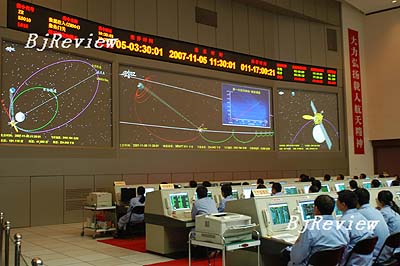|

China's first lunar probe, Chang'e-1, completed the first part of its journey into space on November 7, entering its working orbit of the moon. Following instructions from the Beijing Aerospace Control Center (BACC), it began its third brake at 8:24 a.m. and entered a 127-minute round polar circular orbit at 8:34 a.m. The round orbit is the final destination of the probe, where it will carry out a series of planned scientific exploration tasks over the next year.
"Chang'e-1 is an extraordinary achievement, since it's the first time that Chinese scientists have managed to maneuver a satellite, 390,000 km away from the Earth," said Wang Yejun, Chief Engineer of BACC.
"The probe will travel along the orbit at a stable altitude of 200 km above the moon's surface. In each circle, it will pass the two poles," Wang said.
"The satellite entered the designed working orbit just in time and very accurately, said Sun Jiadong, Chief Designer of China's lunar probe project, who has spent more than a decade developing and testing the lunar probe in preparation for its mission.
Ye Peijian, Chief Commander and Designer of the satellite system for the lunar mission, considered it "a landmark moment." "It proves that we have the ability to send our satellite to circle around the moon," he said.
China sent its first satellite into the Earth's orbit in 1970. The country carried out its maiden piloted space flight in October 2003, making it the third country after the former Soviet Union and the United States to have sent men into space. In October 2005, China completed its second manned space flight, with two astronauts on board.
Extended life span
Chang'e-1 was originally designed to stay in the moon's orbit for one year, but Tang Geshi, an official in charge of the orbital control with BACC, estimated that smooth operations and precise maneuvers may have saved 200 kg of fuel and could help to prolong the probe's lifespan.
The BACC cancelled two orbital corrections, which saved a considerable amount of fuel, as Chang'e-1 was running accurately on its expected trajectory. In its 15-day flight, the probe experienced four orbital transfers, one orbital correction and three brakes, and each maneuver used a lot of fuel.
"All the maneuvers in the flight have been completed precisely. The level of accuracy has been much higher than our expectations," Ye said.
The satellite was supposed to position all of its instruments to face the moon on November 18, a posture facilitating its probing work, said Li Jian, an official with the BACC.
However, Zhou Jianliang, Deputy Chief Engineer of the BACC, revealed that it is considering giving an order to do this ahead of schedule, since the satellite is in "a very good state."
Well begun is half done
"The probe's precise entry into the moon's orbit has laid a solid foundation for its future work, and we are confident that Chang'e-1 will continue to fulfill its aims step by step," said Ma Xingrui, General Manager of the China Aerospace Science and Technology Corporation (CASTC) in charge of rocket and satellite systems.
The 2,350-kg satellite carried eight probe facilities, including a stereo camera and interferometer, an imager and gamma-/x-ray spectrometer, a laser altimeter, a microwave detector, a high-energy solar particle detector and a low-energy ion detector.
According to the project's plan, Chang'e-1 will open all the instruments aboard it to start scientific explorations after a period of orbit testing.
"Currently, all the facilities are in very good condition. Next, scientists need to maintain smooth communication between the ground and the satellite and keep it in the orbit," said Zhang He, Director of the CASTC's space technology research institute.
"One of the major tasks of Chang'e-1 is to probe mineral elements on the moon, especially those not existent on Earth," Zhang said. "The lunar regolith is abundant in helium-3, a clean fuel that may support the Earth's energy demands for more than a century."
Chang'e-1 will relay the first black-and-white picture of the moon after its instruments are positioned toward the moon.
"Actually, what the probe transmits back is just abstract data, which will need six hours to be processed into a two-dimensional picture and about a day to be made into a 3-D one," Li said. | 